
The park is full of beautiful plants and while most of them are native to the area; there are a few nonnative species as well. Some nonnative plant species don't create a problem, while others, such as mile-a-minute, spongy moth, spotted lantern fly, barberry, Japanese knotweed, wisteria, Japanese stiltgrass, tree of heaven, multiflora rose, Oriental bittersweet, Chinese lespedeza, hemlock woolly adelgid, dutch elm disease, and the chestnut blight may have serious consequences for forest ecosystems. These invasive species are managed by the park so they do not overtake the native park species.
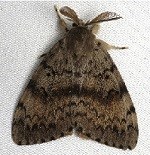
NPS Photo Spongy Moth, Lymantria disparThis moth, formerly known as the gypsy moth, is named for the sponge-like egg masses that it lays on tree trunks and other outdoor surfaces. Accidentally introduced in the 1800s from France with a shipment of silk moths that got loose, this moth defoliates (strip the leaves from) the trees on which it feeds. Though trees can sometimes survive defoliation, if left unchecked, this moth will spread rapidly and an overly large population of moths can kill many trees in a forest.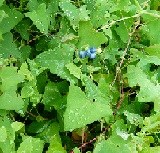
NPS Photo Mile-a-minute, Persicaria perfoliataThis fast growing weed is native to India and Eastern Asia and was accidentally introduced by contaminated seed into York County, Pennsylvania in the 1930s. As the name suggests, this vine spreads rapidly and enjoys open, disturbed areas like roadsides and stream banks. Its thick growth will block sunlight, slowing the growth of other plants in the area.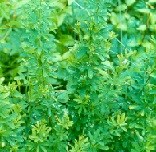
NPS Photo Chinese Lespedeza, Lespedeza cuneataAlso known as bush clover and native to Asia, this low growing plant was introduced to North America for use as forage and erosion control on poor soils. In open areas such as meadows and wetlands, it will spread rapidly, produces many seeds, and can out-compete native grasses if left unchecked. Because seeds can remain viable for up to 20 years, it is really hard to get rid of.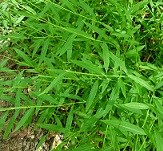
NPS Photo Japanese Stiltgrass, Microstegium vimineumAlso known as Nepalese browntop, Japanese stiltgrass is considered one of the most damaging invasive plant species in the United States. Native to Asia, infestations will spread rapidly and crowd out native species. It is hard to get rid of as the seed can remain viable to sprout in the soil for up to five years.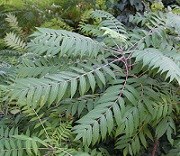
NPS Photo Tree of Heaven, Ailanthus altissimaThis rapidly growing tree is native to China and was brought over as an easy growing ornamental in the 1700s. It is known to produce a toxin in its leaves and bark that can inhibit the growth of other plants. Tree of Heaven will often grow in thickets in open disturbed areas, crowding out native plants and can even cause damage to sewers and building foundations.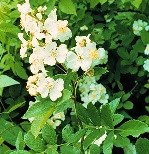
Multiflora Rose, Rosa multifloraThis rose, while beautiful to look at, can quickly form impenetrable thickets that exclude native plant species if left to grow unchecked. Introduced from Eastern Asia in the late 1700s as an ornamental plant and used at times as a living fence, multiflora rose grows in sunny areas near roadsides and forest edges crowding out other plants.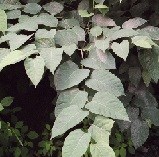
NPS Photo Japanese Knotweed, Fallopia japonicaA fast growing plant, Japanese knotweed can burst through pavement or sneak in through foundation cracks in your house! A lover of sunny areas that have been disturbed by human activity, this knotweed can grow as much as 10 feet a season when established. When growing near stream edges, it can crowd out native plants and potentially affect stream nutrients and disrupt local ecosystems.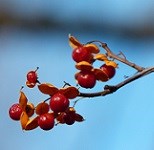
Oriental Bittersweet, Celastrus orbiculatusOriental bittersweet can establish itself from both sprouts and seeds which can cause it spread quickly, crowding out native plants if left unchecked. Native to Eastern Asia and introduced here as an ornamental and for erosion control, this vine can smother plants and uproot trees due to its weight if left unchecked.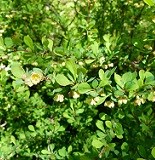
Japanese Barberry, Berberis thunbergiiLike other invasives, Japanese Barberry was introduced as an ornamental plant. Native to Japan and introduced here in the late 1800s, this shrub will form dense stands that compete with native trees and other plants.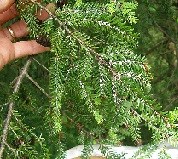
NPS Photo Hemlock Woolly Adelgid, Adelges tsugaeThis invasive insect may be tiny and hard to spot. Often an infestation can be spotted by seeing the small white egg sacs on branches of the hemlock tree. After hatching, these aphid-like insects suck sap from hemlock needles, killing needles, shoots and branches. Accidentally introduced from Japan sometime in the 1900s, they destroy Eastern hemlock trees.Chestnut Blight, Cryphonectria parasiticaThe American chestnut was very prolific in this area in the early 1900s. They were valued both for their lumber and for their nuts. In 1904, a Chinese chestnut was brought from Asia and planted in the Bronx Zoo. At that time, no one knew the Chinese chestnut carried with it a fungus known today as the chestnut blight. If you are lucky, you may still find a American chestnut in the woods today. Often, they die right after they reproduce when the tree is at its weakest.Dutch Elm Disease, Ophiostoma ulmiLike the Chestnut Blight, Dutch Elm Disease was accidentally brought to the United States from the Netherlands in 1928. Dutch Elm disease is generally transported three different ways: by beetles, by humans who use a saw to cut down an affected elm and then go and use the same saw to prune a healthy tree, and finally by the ability to move through the roots system to attack new and healthy trees. |
Last updated: March 12, 2023
